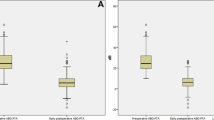Abstract
Advances in operative technique, instrumentation, and prosthesis design in otosclerosis surgery continue since Shea performed the first successful surgery. This is the first analysis to specifically compare post-operative hearing outcomes following stapedotomy surgery performed under local versus general anesthesia. Hearing outcomes were further stratified by comparing conventional perforator and Er:YAG laser ablation perforation techniques. Pre- and post-operative audiograms were retrospectively analyzed together with the method of anesthesia and the perforation technique for all patients with otosclerosis who underwent stapedotomy between 1998 and 2007. Pre-operative individual standard audiometry frequency thresholds (IFTs), air (AC) and bone conduction pure tone averages (PTA), and air bone gaps (ABG) were compared against post-operative results. Differences between pre- and post-operative PTAs and ABGs were compared between patients who received stapedotomy under local versus general anesthesia, as well as for patients who underwent conventional versus Er:YAG laser ablation perforations. Eighty-six patients were identified of which 24 % (n = 21) received local and 76 % (n = 65) received general anesthesia. Post-operative audiograms were available for 84 and 48 patients, respectively. Significant improvements were seen across all groups for standard 4-frequency AC-PTA and ABG and for IFTs up to 3 kHz. No significant difference was seen for IFTs between 4 and 6 kHz. A significant decline in post-operative hearing thresholds was seen at 8 kHz. Significant improvements in PTA and ABG were seen for all groups. There was a trend toward general compared to local anesthesia post-operative hearing results furthermore in combination with conventional perforation technique then with laser technique.



Similar content being viewed by others
References
Shea JJ Jr (1958) Fenestration of the oval window. Ann Otol Rhinol Laryngol 67(4):932–951
Shea JJ Jr (1998) A personal history of stapedectomy. Am J Otol 19(5 Suppl):2–12
Shea JJ (1956) Symposium on stapes mobility. Laryngoscope 66:775–777
Hausler R (2007) General history of stapedectomy. Adv Otorhinolaryngol 65:1–5
Plester D (1970) Advances in the microsurgery of the ear during the lst 10 years. HNO 18(2):33–40
Shea JJ Jr (1963) The teflon piston operation for otosclerosis. Laryngoscope 73:508–509
Marquet J (1965) Le syndrome de surdité dû à une déficience de la prothèse stapédienne. Soc Fr Orl CR Sci Congr 151–160
Fisch U (1994) Tympanoplasty, mastoidectomy, and stapes surgery. Georg Thieme, Stuttgart
Brase C et al (2013) Bone conduction after stapes surgery: comparison of CO2 laser and manual perforation. Otol Neurotol 34(5):821–826
Marchese MR et al (2011) “One-shot” CO2 versus Er:YAG laser stapedotomy: is the outcome the same? Eur Arch Otorhinolaryngol 268(3):351–356
Parrilla C et al (2008) Erbium: yttrium–aluminum–garnet laser stapedotomy—A safe technique. Otolaryngol Head Neck Surg 138(4):507–512
Vincent R et al (2012) KTP versus CO2 laser fiber stapedotomy for primary otosclerosis: results of a new comparative series with the otology–neurotology database. Otol Neurotol 33(6):928–933
Vogel A, Venugopalan V (2003) Mechanisms of pulsed laser ablation of biological tissues. Chem Rev 103(2):577–644
Hausler R et al (1999) Advantages and dangers of erbium laser application in stapedotomy. Acta Otolaryngol 119(2):207–213
Cuda D et al (2009) Microdrill, CO2-laser, and piezoelectric stapedotomy: a comparative study. Otol Neurotol 30(8):1111–1115
Forton GEJ et al (2009) CO2 laser-assisted stapedotomy combined with a Wengen titanium clip stapes prosthesis: superior short-term results. Otol Neurotol 30(8):1071–1078
Hornung JA et al (2009) First experience with a new titanium clip stapes prosthesis and a comparison with the earlier model used in stapes surgery. Laryngoscope 119(12):2421–2427
Jovanovic S et al (1996) Effects of continuous-wave laser systems on stapes footplate. Lasers in Surg Med 19(4):424–432
Kodali S, Harvey SA, Prieto TE (1997) Thermal effects of laser stapedectomy in an animal model: CO2 versus KTP. Laryngoscope 107(11 Pt 1):1445–1450
Ryan S et al (2009) A comparison of CO2 laser versus traditional stapedectomy outcomes. Irish Med J 102(7):218–220
Sakamoto T et al (2010) Comparison of hearing improvement and complications after stapes surgery with and without potassium titanyl phosphate laser for manipulation of the foot plate. ORL J Otorhinolaryngol Relat Spec 72(1):16–21
Vincent R et al (2010) A nonrandomized comparison of potassium titanyl phosphate and CO2 laser fiber stapedotomy for primary otosclerosis with the otology-neurotology database. Laryngoscope 120(3):570–575
Lavy JA, Powell HR (2013) Stapes surgery under local anaesthesia. Ann R Coll Surg Engl 95(1):37–39
Vital V et al (2008) Minimizing the dead ear in otosclerosis surgery. Auris Nasus Larynx 35(4):475–479
Babighian GG, Albu S (2009) Failures in stapedotomy for otosclerosis. Otolaryngol Head Neck Surg 141(3):395–400
Monsell EM et al (1995) Committee on Hearing and Equilibrium guidelines for the evaluation of results of treatment of conductive hearing loss (1995) American Academy of Otolaryngology-Head and Neck Surgery Foundation, Inc. Otolaryngol Head Neck Surg 113(3):186–187
Schmid P, Hausler R (2009) Revision stapedectomy: an analysis of 201 operations. Otol Neurotol 30(8):1092–1100
Berliner KI, Doyle KJ, Goldenberg RA (1996) Reporting operative hearing results in stapes surgery: does choice of outcome measure make a difference? Am J Otol 17(4):521–528
Marchese MR et al (2007) Role of stapes surgery in improving hearing loss caused by otosclerosis. J Laryngol Otol 121(5):438–443
House HP et al (2002) Stapedectomy versus stapedotomy: comparison of results with long-term follow-up. Laryngoscope 112(11):2046–2050
Spandow O, Soderberg O, Bohlin L (2000) Long-term results in otosclerotic patients operated by stapedectomy or stapedotomy. Scand Audiol 29(3):186–190
Levy R, Shvero J, Hadar T (1990) Stapedotomy technique and results: ten years’ experience and comparative study with stapedectomy. Laryngoscope 100(10 Pt 1):1097–1099
Mishiro Y et al (2009) Prognostic factors for short-term outcomes after ossiculoplasty using multivariate analysis with logistic regression. Arch Otolaryngol Head Neck Surg 135(8):738–741
Author information
Authors and Affiliations
Corresponding author
Rights and permissions
About this article
Cite this article
Loewenthal, M., Jowett, N., Busch, CJ. et al. A comparison of hearing results following stapedotomy under local versus general anesthesia. Eur Arch Otorhinolaryngol 272, 2121–2127 (2015). https://doi.org/10.1007/s00405-014-3014-6
Received:
Accepted:
Published:
Issue Date:
DOI: https://doi.org/10.1007/s00405-014-3014-6




